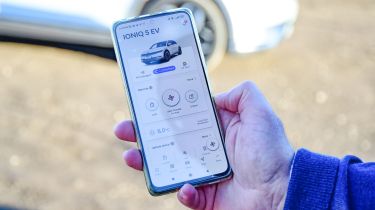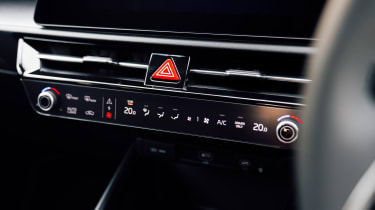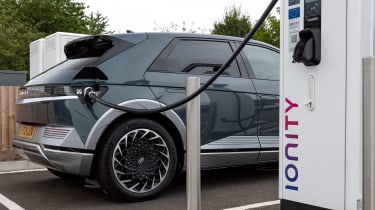What is pre-conditioning?
Heating or cooling your car, and pre-conditioning its battery before you leave, is an electric-car luxury everyone should enjoy

In the dark days before electric cars, drivers climbing into their vehicles were usually forced to put up with whatever cabin temperature the elements had deigned to create.
In sub-zero conditions it was a case of running the engine and cranking up the heaters, then breaking-out the ice scraper or sitting tight to wait for the thaw. If you’d parked in the summer sun, you were effectively climbing into a mobile oven – with scolding metal surfaces and an uncomfortable wait until the air-con found its feet. But all this was before the electric car and the marvel of preconditioning.
Quite simply, pre-conditioning is the simple process through which the vehicle can heat or cool itself in advance, either to prepare for a comfortable and prompt departure, or to optimise the battery temperature for charging.
Unlike petrol or diesel cars where the engine needs to be running to generate heat or run the climate control system for cooling, electric cars can be programmed to create the desired cabin or battery temperature, without any of the harmful tailpipe emissions. What’s more, if your car is plugged in at the time, you won’t have to sacrifice any range.
There is nothing like emerging from your house into a freezing winter morning to the sound of neighbours hacking away at their frozen windscreens with their credit cards, only to climb into your balmy preconditioned electric car and drive away.

How does preconditioning a car work?
The fact that electric cars have heating and cooling systems that run on power from the battery rather than from an engine opens up a range of possibilities. Owners of electric or plug-in hybrid cars will know that they can set a charging schedule so that the car will draw power to charge its battery at times when the electricity is cheapest. The preconditioning functionality is an extension of this and is available on the majority of modern electric cars.
Using the car’s infotainment system or the accompanying smartphone app, it’s possible to schedule preconditioning ahead of your predicted departure time. The preconditioning system will turn the car on in advance, and begin to heat or cool it as desired.
Alternatively, you can simply turn on the car’s climate control remotely when you know you’re nearly ready to leave, so that the cabin is at the optimum temperature when you climb into the driver’s seat. You’ll be amazed at how quickly it functions, too – as there’s no need to wait for the engine to warm through, your cabin will be toasty warm in a matter of minutes.
Be aware though that there is a distinction between adjusting the climate control in your car’s cabin remotely and using a full preconditioning function that also works on the battery. The way in which the system works varies from model to model.

What are the advantages of preconditioning your car?
The obvious advantage to preconditioning is comfort and time saved on winter de-icing, but there are other reasons to precondition your EV that are arguably more beneficial.
It is a fact that electric cars suffer from reduced range in cold weather – caused by the extra energy diverted to heating the vehicle for comfort but also by efficiency losses caused by slower chemical reactions in the battery. By preconditioning your car’s battery so that it’s up to temperature before you leave, you can reduce these losses and get the maximum range from your EV.
Preconditioning your car before charging is also good for the long term health of your battery. It means that the battery is at the optimum temperature to accept a charge and this will help preserve the cells as well as delivering more efficient charging. If your battery isn’t at the optimum temperature when you plug the car in, you may find it charges slower than expected.
Some electric cars, including the Porsche Taycan will automatically heat or cool their batteries constantly while on the to keep it within the optimum temperature range for the best possible efficiency – also allowing it to maintain higher charging speeds, for longer.
To get the best performance when preconditioning a car it’s important to have a model with a heat pump that can generate the heat needed to warm that cabin and battery more efficiently. Heat pumps are becoming more and more common as standard equipment, but they are still optional on some models and can be a wise investment – especially in cooler climates.
Does preconditioning improve an EV’s range?
Preconditioning can help your electric car go further on a charge but it’s really about making the most of the range you have rather than helping your EV go further. Remember that preconditioning as an aid to efficiency depends to a large extent on whether or not the car is plugged in when the system activates.
If the car is plugged in, the preconditioning is done using power from the mains supply and will not draw electricity from the car’s battery. If the car is parked on the street, the opposite is true. You’ll get a lovely warm cabin to climb into but it will be at the expense of the battery charge used to generate that heat and your range will be reduced. Most cars will not precondition their batteries if the car is not plugged in to a charger ready to charge.
Recommended

EV Deal of the Day: Dacia Spring is amazingly good value at £116 per month

EV Deal of the Day: budget-friendly Ford Capri for just £234 a month
Most Popular

EV Deal of the Day: Dacia Spring is amazingly good value at £116 per month

EV Deal of the Day: budget-friendly Ford Capri for just £234 a month



